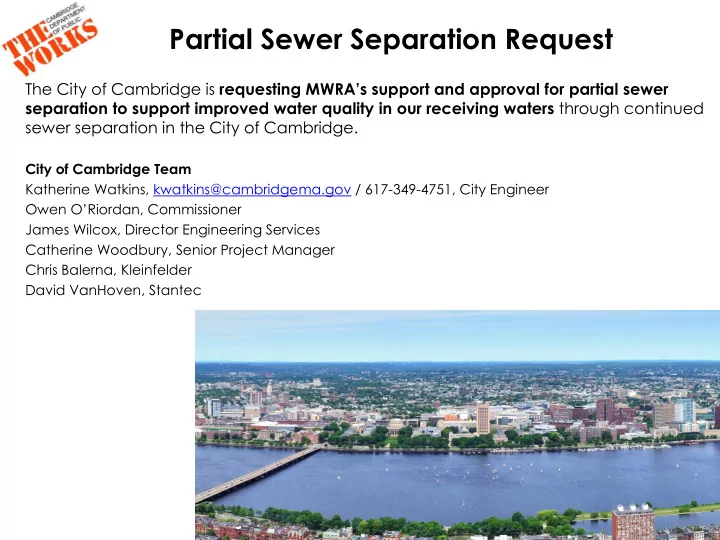

Partial Sewer Separation Request The City of Cambridge is requesting MWRA’s support and approval for partial sewer separation to support improved water quality in our receiving waters through continued sewer separation in the City of Cambridge. City of Cambridge Team Katherine Watkins, kwatkins@cambridgema.gov / 617-349-4751, City Engineer Owen O’Riordan, Commissioner James Wilcox, Director Engineering Services Catherine Woodbury, Senior Project Manager Chris Balerna, Kleinfelder David VanHoven, Stantec
Partial Sewer Separation Request The City of Cambridge is requesting MWRA’s support and approval for partial sewer separation to support improved water quality in our receiving waters through continued sewer separation in the City of Cambridge. Agenda Review Cambridge System • Cambridge and MWRA Collaboration • What is Cambridge doing for stormwater management • Details of request • Questions / Discussion •
Cambridge combined sewer community (45%). MWRA and Cambridge are collectively in the stormwater business. Sewer Separation – traditional approach. Partial Sewer Separation (stormwater overflow) focus on larger storm flows.
Cambridge and the MWRA have been strong partners during the implementation of the LTCP for the Alewife Brook and the Charles River. Committed to collaborating with the MWRA to improving water quality and continue reducing CSO discharges.
Cambridge committed to stormwater management and improving water quality.
Commitment to Stormwater Management City Projects – Large to Small 3.5-acre Alewife Stormwater Wetland. $13.8M+ project funded by the City as part of the larger Alewife Sewer Separation Program. September, 2019
Commitment to Stormwater Management City Projects – Large to Small 480,000 gallon stormwater tank currently under construction in Central Square. $20M+ project funded by City and MWRA II funds.
Commitment to Stormwater Management City Projects – Large to Small
Commitment to Stormwater Management Private Development Plays a Role Rain Garden at Stata Center, MIT Requiring private development to reduce 65% phosphorous, required 51%
Cambridge committed to stormwater management and improving water quality. Partial Sewer Separation – additional tool.
How does combined sewer system currently work during larger storms? All sewage and stormwater is combined and goes to the MWRA system until there is a CSO activation.
Full Sewer Separation All stormwater goes to the receiving water bodies. Reduces CSOs. Increases phosphorous and other nutrients. Not consistent with Phosphorous TMDL in the Charles River and impaired status of Alewife Brook.
How would system work with partial sewer separation? During smaller storm events the stormwater stays connected to the MWRA system; reducing the impact of phosphorous and other nutrients on the river. During larger storm events, stormwater is diverted to the river; reducing the frequency and volume of CSOs.
Two Projects Proposed for Partial Sewer Separation Western Avenue and Cambridgeport (Talbot Street Outfall). Both of these projects reduce CSO volumes at MWRA facilities. Partial and full sewer separation provide similar levels of CSO benefit to the MWRA’s system. However, partial sewer separation also reduces the impact of phosphorus and other nutrients on the receiving waters. Both Cambridge and the MWRA understand the importance of continued sewer separation to the MWRA meeting the LTCP and continuing to decrease CSO activations and volumes. Cambridge coordinating technical analysis with MWRA staff.
Cambridgeport – Talbot Street Outfall Consistently identified by the MWRA as critical to reducing the CSO volumes at Cottage Farm to under the LTCP of 6.30 MG. But the MWRA has not committed funding to this project. The $12M to $15M+ partial sewer separation in the Cambridgeport area (Talbot Street outfall) is being constructed with no MWRA Funding. With Partial Sewer Separation – stormwater during larger CSO storm events is directed to the Charles River, which is why the typical year CSO activations are the same under full sewer separation and partial sewer separation.
Cambridgeport – Talbot Street Outfall The project reduces the existing 10” and 18” connections from the Cambridge drainage system to the MWRA sewer system to 2 - 6” connections (shown in orange in the map above). This project is critical for the MWRA to meet the level of CSO control required at Cottage Farm. Existing Conditions – 7.29 MG Long Term Control Plan – 6.30 MG Full Sewer Separation – 4.71 MG Partial Sewer Separation – 4.71 MG Analysis from March 1, 2019 Letter from the City of Cambridge to the MWRA, includes Cottage / Lopez improvements (using 2017 Cambridge Model).
Western Ave $25M+ project to construct a new outfall funded solely by the City of Cambridge. Additional phases would continue partial sewer separation in 40 acre catchment area. Partial sewer separation provides the same level of CSO benefit , while reducing the impact of phosphorus and other nutrients on the Charles River. 40 acres of currently Combined Area Connected to MWRA
Western Ave $25M+ project to construct a new outfall funded solely by the City of Cambridge. Additional phases would continue partial sewer separation in 40 acre catchment area. Partial sewer separation provides the same level of CSO benefit , while reducing the impact of phosphorus and other nutrients on the Charles River. Analysis from February 8, 2017 Letter from Cambridge to MWRA Deflection Structure
Partial Sewer Separation Request Reduces stormwater going to the MWRA system and is for combined sewer areas only . Critical to the MWRA meeting the Long Term Control Plan and continuing to improve the level of CSO control, however, sewer separation cannot continue without considering and mitigating the water quality impacts of sending additional stormwater to the receiving waters . Develop designs that reduce CSOs and improve water quality (phosphorous) controls. These projects significantly benefit the MWRA system by reducing flows to the system and reducing CSO activations and volumes. No cost to the MWRA and will result in a better performing MWRA system for all communities .
For more information: City of Cambridge Department of Public Works 147 Hampshire Street Cambridge, MA 02139 617-349-4800 www.cambridgema.gov/theworks/tenyearplan
Recommend
More recommend